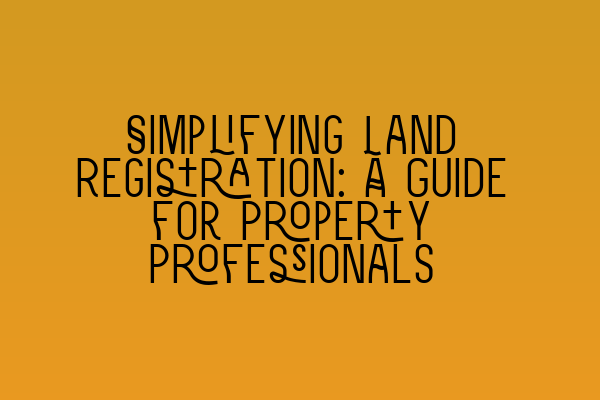Simplifying Land Registration: A Guide for Property Professionals
Welcome to SQE Property Law & Land Law, your trusted resource for all matters related to property law. Today, we are here to guide property professionals like you through the often complex world of land registration. Understanding the land registration process is crucial in ensuring the smooth transfer of property ownership and avoiding legal complications. In this comprehensive guide, we will break down the key concepts and procedures involved in land registration, making it easier for you to navigate this area of property law.
What is Land Registration?
Land registration is the process of officially recording ownership and interests in land. It is essential for establishing and maintaining a clear and secure system of land ownership. In the United Kingdom, land registration is governed by the Land Registration Act 2002. This legislation introduced a centralized system known as the Land Registry, which manages all land registration activities.
Before the Land Registration Act 2002, land ownership was often determined by examining a series of legal documents called “title deeds.” However, this system was prone to errors, disputes, and fraud. The introduction of the Land Registry greatly simplified the process and enhanced the security of land ownership.
Key Principles of Land Registration
Understanding the key principles of land registration is fundamental to comprehending the process as a property professional. Let’s explore them:
1. Mirror Principle:
The mirror principle is the cornerstone of the land registration system. It states that the register should reflect an accurate and up-to-date picture of the state of the title. In other words, the information recorded in the register should accurately represent the ownership and any registered interests in the land.
For example, if Mr. A owns a piece of land, the register should reflect Mr. A as the registered proprietor. Additionally, any registered interests, such as a mortgage, should also be reflected in the register.
2. Curtain Principle:
The curtain principle helps to provide certainty and protection for parties dealing with land. It means that third parties can rely on the information in the register without having to investigate the underlying title documents. This principle gives confidence to buyers, lenders, and other stakeholders by ensuring that the information in the register is sufficient to determine the state of the title.
For instance, if a potential buyer conducts a search at the Land Registry and finds no registered interests other than the owner, they can have confidence that the property is not encumbered by any undisclosed interests.
3. Insurance Principle:
The insurance principle is another essential aspect of land registration, offering protection for registered proprietors against loss in the event of certain types of fraud or error. When an individual purchases a property and their details are registered in the Land Registry, they are protected by an indemnity, which covers any legitimate claims arising from a mistake or fraud in the registration process.
This principle provides added security and peace of mind to property owners, as any losses incurred due to errors or fraud in the registration process can be compensated.
The Land Registration Process
Now that we have covered the key principles, let’s dive into the land registration process:
1. Application for First Registration:
When a property is not yet registered with the Land Registry, the first step is to apply for first registration. This requires submitting an application to the Land Registry, along with the necessary supporting documents.
For properties with existing title deeds, the application will involve converting the information from the title deeds into the Land Registry’s prescribed format. Once the application is processed and approved, the property will be assigned a unique title number and entered into the Land Registry’s register.
2. Application for Registration of Disposition:
When a property undergoes a change in ownership or interests, such as a sale, transfer, or creation of a mortgage, an application for registration of disposition is required. This application is submitted to the Land Registry, along with the relevant documents and fees.
It is crucial to ensure that all necessary parties, such as the current owner, buyer, and lender, are involved in the application to avoid any complications or delays in the registration process.
3. Examination and Approval:
Once the application for registration is submitted, the Land Registry will examine the documents and check for any discrepancies or issues. They may request additional information or clarification if required.
It is important to provide accurate and complete information to avoid any unnecessary delays in the approval process. Working with an experienced solicitor can help ensure a smooth examination and approval process.
4. Issue of Certificate of Title:
After the application is approved, the Land Registry will issue a Certificate of Title. This certificate is a legal document confirming the current ownership and registered interests in the property.
The Certificate of Title is a crucial document that protects the legal rights of the registered proprietor. It is essential to keep it safe and secure.
Conclusion
Understanding land registration is vital for property professionals to effectively navigate the complexities of property transactions. The key principles of land registration, including the mirror principle, curtain principle, and insurance principle, provide the foundation for a transparent and secure system of land ownership.
By following the land registration process, which includes applying for first registration and registration of disposition, property professionals can ensure a smooth and legally compliant transfer of property ownership.
At SQE Property Law & Land Law, we are committed to providing expert guidance and support for property professionals. For more information on related topics, check out our articles on Misrepresentation in Contracts: Unveiling Deceptive Practices, SQE Contract Law: Analyzing Landmark Cases and Influential Judicial Decisions, Understanding Contractual Capacity: Rights and Limitations, Interactive SQE Mock Tests for Contract Law: Test Your Knowledge, and Join Our SQE Contract Law Webinars: Expert Insights and Guidance.
Stay tuned for more informative content from SQE Property Law & Land Law!
